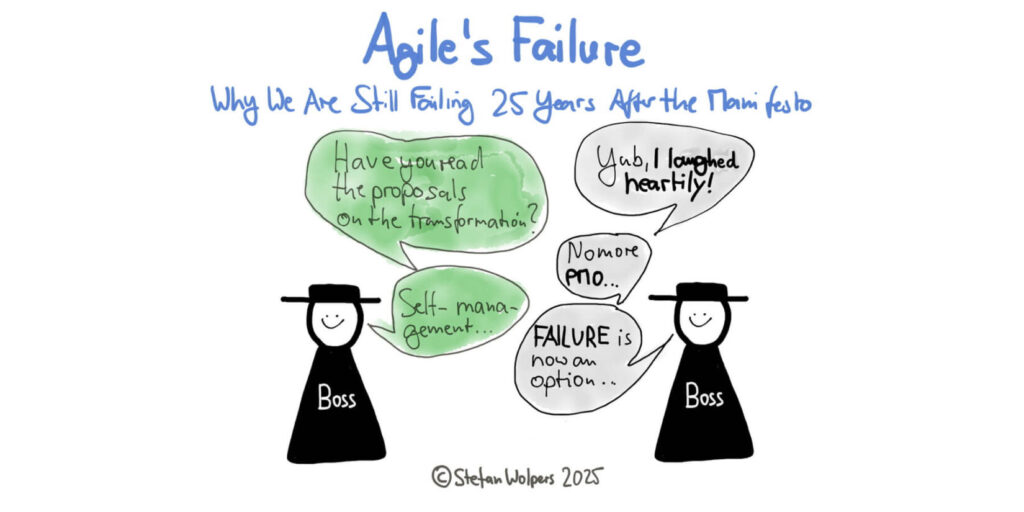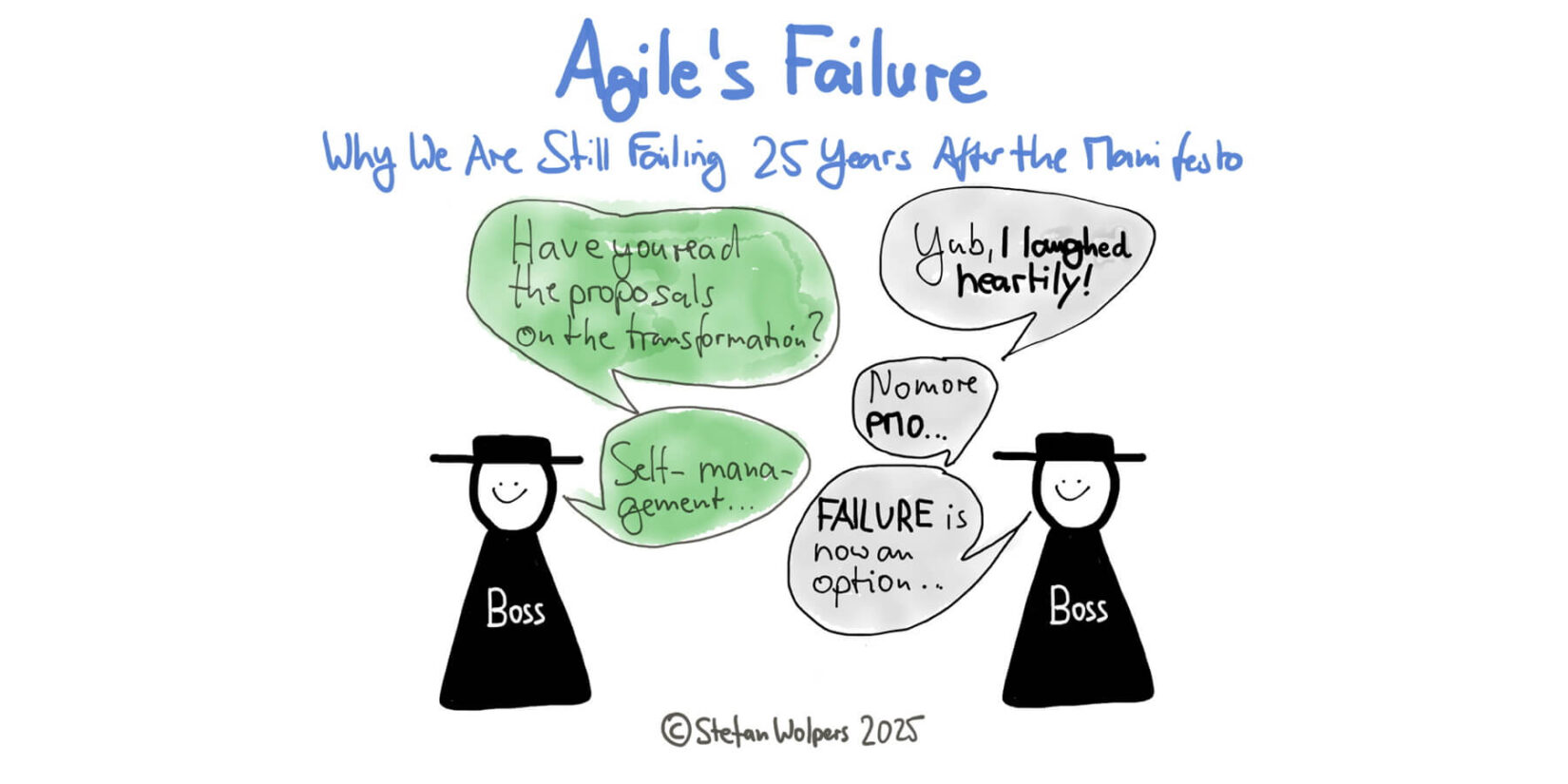TL; DR: Agile Failure at Corporate Level
The data couldn’t be more supportive: Despite 25 years of the Agile Manifesto, countless books, a certification industry, conferences, and armies of consultants, we’re collectively struggling to make Agile work. My recent survey, although not targeting Agile failure, still reveals systemic dysfunctions that persist across organizations attempting to implement Agile practices:
- Impediment #1: Leadership disconnect (33 % of respondents cite management issues).
- Impediment #2: Missing product vision (12 % of respondents can’t see the “why”).
- Impediment #3: Cultural resistance (12 % of respondents report mindset barriers).

🇩🇪 Zur deutschsprachigen Version des Artikels: Agile in der Krise: Warum wir 25 Jahre nach dem Manifest immer noch scheitern.
🗞 Shall I notify you about articles like this one? Awesome! You can sign up here for the ‘Food for Agile Thought’ newsletter and join 42,000-plus subscribers.
🎓 🖥 🇬🇧 The AI-Enhanced Advanced Product Backlog Management Course Version 2—July 1, 2025
Are you facing problems aligning vision, stakeholders, your team, and delivering real value?
Is your contribution as a product leader questioned?
Then, prepare to transform your career with my AI-enhanced, comprehensive, self-paced online class. Dive deep into professional Product Backlog management techniques supported by videos, exercises, and the latest AI models.
👉 Please note: The course will only be available for sign-up until July 7, 2025!
🎓 Join the Launch of the AI-Enhanced Version 2 on July 1: Learn How to Master the Most Important Artifact for any Successful Agile Practitioner!
1. About the Data
- Sample size: 165 Agile practitioners.
- Collection period: May 13-17, 2025.
- Demographics: 27.3% Agile Coaches, 20.6% Scrum Masters, 9.7% Product Owners/Product Managers, 7.9% Agile Project/Delivery Managers, 5.5% Consultants, 29.0% Other.
- Methodology: Open-ended question format with keyword analysis and thematic clustering.
- Key question: “What’s your biggest frustration when applying Agile or Scrum in your organization?”
2. The Leadership Paradox: Our Greatest Impediment
The most significant obstacle isn’t technical debt or inadequate tooling—it’s leadership. With 55 responses highlighting management issues, this category towers above all others.
These aren’t complaints about simple micromanagement. They reflect fundamental disconnects where leaders verbally endorse Agile while undermining its principles through their actions: “We are working for big companies, most of the time they want to know exactly what something will cost and by when it will be ready. This is a bad fit to try and do this in an agile way, however, doing it in a waterfall way also doesn’t yield the correct results, so we’re often stuck in a sort of iterative waterfall where guarding scope creep is the main focus.”
3. The Vision Void
12% of respondents cited a lack of product vision and value focus, equal to cultural resistance. When teams efficiently deliver features nobody wants, we’ve optimized the wrong thing, the Feature Factory: “We sprint like Olympic athletes, but nobody knows toward what finish line” — Scrum Master, retail technology.
For Agile Project Managers, this ranked as their top frustration. Without clarity on “why” we’re building something, the “how” becomes meaningless.
Cannot see the subscription form?
Please click here
Cannot see the subscription form?
Please click here
4. The Culture Conundrum Leading to Agile Failure
Another 12% pointed to mindset and cultural resistance. After 25 years, why are we still treating Agile as something that requires a “transformation” rather than organizational common sense? The absence of psychological safety prevents teams from experimenting. Agile becomes mechanical without permission to learn through trial and error: “People who know very little about agile who perpetuate misconceptions and make it very difficult to introduce an agile mindset.”
We’ve focused too much on frameworks and promises and not enough on values. When organizations adopt Scrum processes while maintaining command-and-control mindsets, they try to pour new wine into old bottles.
5. The Structural and Systemic Mismatches
Seven responses (4%) highlighted organizational structure problems. This “Conway’s Law in action” creates departments moving at different speeds, neutralizing potential Agile gains. This mismatch creates silos where teams optimize locally without regard for overall strategy, often driven by misaligned incentives: “The biggest pain from my perspective is that management, developers and many product people alike stick to optimising for outcomes and full utilisation. There’s a common understanding that this is how it’s done in an efficient and “professional” company.”
6. The Implementation Trap
Sixteen responses (10%) about process misapplication reveal a troubling pattern: we’ve become skilled at doing Agile poorly. Never-ending standups, political estimation sessions, and action-item graveyards aren’t Agile failures; they are visible organizational dysfunctions: “We define improvements each Retro and they are all valuable, but over time this also becomes too much for teams and too many rules we agreed to follow, and it leads to exhaustion.”
7. Breaking the Cycle: Avoiding Agile Failure Requires Radical Honesty
After 25 years, it’s time for uncomfortable truths:
- Agile isn’t for everyone. Some organizations might perform better with traditional approaches. Forcing Agile where it doesn’t fit creates the very dysfunctions we’re seeing.
- Leadership transformation must precede Agile. Agile initiatives become superficial process changes without leaders who understand empiricism and self-organization.
- We’ve emphasized rituals over outcomes. Our community hasn’t always clearly connected practices to business results, sometimes allowing form to supersede function.
- Education isn’t implementation. A two-day course, however excellent, cannot transform an organization. We need honesty about what a certification provides and what it doesn’t.
- Organizational transparency is non-negotiable. Without visibility into vision and strategy, teams cannot self-organize effectively.
- Physical environment matters. Agile isn’t just about mindset and process—it requires spaces designed for collaboration.
8. The Industry’s Uncomfortable Mirror
Many dedicated professionals work tirelessly to advance genuine agility. Yet we must acknowledge how Agile has sometimes become more product than philosophy. This isn’t about individual practitioners—most genuinely want to help organizations improve. Instead, it’s about systemic incentives that gradually shift focus from transformation to transaction.
The uncomfortable truth is that our industry sometimes benefits from complexity that necessitates ongoing intervention rather than self-sufficiency. We must ask: Are we building organizational capability or organizational dependency? (Apparently, the latter is more lucrative in the long run.)
Conclusion: Less Frameworks, More Fundamentals to Avoid Agile Failure
What if, instead of asking, “How do we implement Agile better?” we asked: “What business problems are we trying to solve, and which Agile principles might help us solve them?” This reframing shifts from framework compliance to business outcomes. Agile isn’t the goal—it’s merely a means to achieve organizational goals.
After 25 years, perhaps our greatest challenge hasn’t been implementing Agile practices, but remembering why we needed them: to deliver better software that creates value. Everything else, from events to roles to artifacts, is a means to that end. Let me spin up the old record to avoid Agile failure again: We are not paid to practice Scrum but to solve customers’ problems within the given constraints while contributing to the organization’s sustainability.
Encore: Monday Morning Experiments
- Ask leadership to identify one business outcome they want from Agile.
- Replace one status report with attending an actual Sprint Review.
- Block 30 minutes to formulate your team’s product vision in one sentence.
- Identify one physical space barrier and propose a simple solution.
- Run one meeting focusing on the “why” before discussing “what” or “how.”
- Note which Agile success metrics are outputs vs. actual business outcomes.
📖 Agile Failure — Related Posts
Agile Failure Patterns in Organizations 2.0
👆 Stefan Wolpers: The Scrum Anti-Patterns Guide (Amazon advertisement.)
📅 Scrum Training Classes, Workshops, and Events
Learn more about Ethical AI in Agile with our Scrum training classes, workshops, and events. You can secure your seat directly by following the corresponding link in the table below:
| Date | Class and Language | City | Price |
|---|---|---|---|
| 🖥 💯 🇬🇧 May 14-June 11, 2025 | SOLD OUT: AI for Agile Practitioners: Pilot Cohort Program (English; Live Virtual Class) | Live Virtual Cohort | €199 incl. 19% VAT |
| 🖥 🇬🇧 May 26-27, 2025 | Professional Scrum Master Advanced Training (PSM II; English; Live Virtual Class) | Live Virtual Class | €1.299 incl. 19% VAT |
| 🖥 💯 🇬🇧 June 5-July 3, 2025 | SOLD OUT: AI for Agile Practitioners: Pilot Cohort Program (English; Live Virtual Class) | Live Virtual Cohort | €249 incl. 19% VAT |
| 🖥 🇩🇪 July 8-9, 2025 | Professional Scrum Product Owner Training (PSPO I; German; Live Virtual Class) | Live Virtual Class | €1.299 incl. 19% VAT |
| 🖥 🇬🇧 July 10, 2025 | Professional Scrum Facilitation Skills Training (PSFS; English; Live Virtual Class) | Live Virtual Class | €599 incl. 19% VAT |
| 🖥 💯 🇬🇧 September 4-25, 2025 | GUARANTEED: AI for Agile BootCamp Cohort #1 (English; Live Virtual Cojort) | Live Virtual Cohort | €249 incl. 19% VAT |
See all upcoming classes here.
You can book your seat for the training directly by following the corresponding links to the ticket shop. If the procurement process of your organization requires a different purchasing process, please contact Berlin Product People GmbH directly.
✋ Do Not Miss Out and Learn more about Agile Failure — Join the 20,000-plus Strong ‘Hands-on Agile’ Slack Community
I invite you to join the “Hands-on Agile” Slack Community and enjoy the benefits of a fast-growing, vibrant community of agile practitioners from around the world.
If you would like to join all you have to do now is provide your credentials via this Google form, and I will sign you up. By the way, it’s free.
The post Agile’s Quarter-Century Crisis: Why We’re Still Failing 25 Years After the Manifesto appeared first on Age-of-Product.com.









